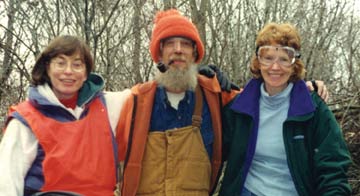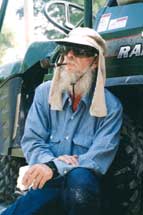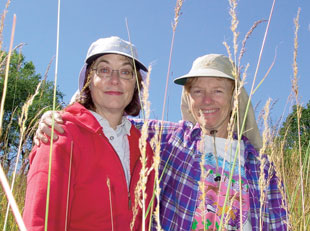Indiangrass Hills: A prairie protected by friends
Posted on October 30, 2006 in Blog

Wading through the tall Indian grass (Sorghastrum nutans), admiring purple spikes of prairie blazing star (Liatris aspera), spooking a buck and noting signs of recent prairie fire, it’s easy to imagine the landscape that greeted Iowa’s first white settlers.
It’s much harder to imagine the landscape that greeted three prairie enthusiasts when they purchased this Iowa County farm just 10 growing seasons ago.
Never mind that, at 480 acres, it was larger than they had planned to buy. And further from their Iowa City homes than they wanted to drive. That its pastured slopes were grazed nearly down to the soil. That they found only a few signs of native plants—some leadplant (Amorpha canescens) and a few sprigs of Indian grass and pale purple coneflower (Echinacea pallida) hiding under an invasive, skin-slashing overgrowth of multi-flora rose.
And never mind that, despite extensive volunteer work on prairies, none knew how to operate a chainsaw or apply herbicides or mend fences. That only one had ever driven a tractor—and only as a kid. That they were making this substantial financial and time commitment after knowing each other only a few years.
Like those early settlers, they took a leap of faith. If you ever doubt that a few people can make a difference, or question whether Iowa has any natural resources worth saving or need courage for your own leap of faith, drive by those prairie-covered slopes today—or read on.
Restorative powers
Judy Felder, Mary Brown and Richard “Sandy” Rhodes met in the mid-1990s while volunteering at prairie projects. Each had discovered prairie restoration at mid-life—and each quickly developed a fascination and then a passion for it.
Convinced that a number of Iowa farms harbor dormant prairies, they looked at many sale lands until they “fell in love with the rolling hills” of a farm west of Williamsburg. They did research to assure that native prairie had been and might still be on site—and then made the plunge.
“As soon as we removed the cows and did some burning, we started seeing native plants in nooks and crannies,” recalls Mary. “Each growing season we found new things, especially after we burned….It’s the surprise and the marvel that keeps us going.”
You hear hints of their restoration successes and love for the land in their affectionate nicknames for seemingly every rise or dip in the landscape: Yellow Warbler Draw, Cup Plant Alley, Liatris [blazing star] Slope, Spiranthes [ladies tresses] Slope, Sunflower Slough, Sunset Ridge, Woodcock Badminton Alley, Turkeyfoot Draw and many more.
Group effort
Despite occasional clashes of opinion, the partners shared labor and management decisions. For example, Sandy researched the ATV purchase, Mary the tractor selection and Judy the pole barn construction. They made sure all three learned to operate each piece of equipment. Together they read manuals, took lessons from local experts and learned by trial and error.
“Some of my favorite memories are times like when the tractor would break down out in the field and we’d all have to figure out how to fix it,” says Judy.
But mostly, they put in hours and hours of labor—aided by volunteer support from friends and neighbors. For example, Ellen Hartz has been a regular volunteer, tour guide, donor and cheerleader since the beginning. Meanwhile, Bill and Barby Buss purchased 160 adjoining acres in 1998, and the group agreed to manage the 640 acres as a unit. In 2005 the Busses donated a conservation easement to the Iowa DNR and sold their land to the original three partners, but they remain actively involved in the restoration effort.
Change in plans
Everything changed—yet didn’t—in 2005, when Sandy was diagnosed with an aggressive cancer. Limiting pain medications to keep his mind sharp, Sandy set about putting his affairs in order—especially the future of Indiangrass Hills.
Sandy died in November 2005, just weeks after the partners donated a conservation easement to the Iowa Department of Natural Resources. At the same time, they donated the land with individual Reserved Life Estates to the Iowa Natural Heritage Foundation. This protection option technically transfers land ownership to INHF but allows donors to maintain typical landowner uses, rights and responsibilities until their deaths.
Sandy also provided for the land’s future health through his estate. INHF’s Richard S. (Sandy) Rhodes II Fund helps to acquire and restore native prairie remnant sites, including Indiangrass Hills, well into the future. Much of the gift provides annual income, in perpetuity, for continued land stewardship at Indiangrass Hills.
Another portion helped INHF purchase additional quality natural areas, with land management goals in keeping with Indiangrass Hills. They are Kothenbeutel Prairie, Wildin Prairie North and Faust Farm.
The final portion of the estate donation ensures that Sandy’s goals are shared with future generations. The new Rhodes Interns, part of INHF’s summer land stewardship crew, will work at Indiangrass Hills, the three sites named above and about 20 other natural areas each year.
Though it was a difficult time for all, Judy and Mary are comforted that their original goal of permanent protection is already assured and pleased that the organizations involved helped the process go quickly and smoothly. “The whole thing just felt right,” says Judy.
“We want this land to honor Sandy’s dream—he had the vision,” says Judy. “But it’s not to be maintained as a museum.”
With that in mind, they are generous about allowing others on the land. They have invited local hiking, prairie and birding groups. They permit hunting by request. They’ve hosted research projects on native species.
Silent partners
Like Sandy, the land itself has a continuing presence and partnership here.
“Sometimes it’s like the land is listening, like it’s doing things for us,” says Mary. “Like one time Judy said she wished she could find an orchid growing here, and soon after we did. And that’s just one example.”
“It often takes two or three burns to see what’s there,” says Judy.
Both are disturbed that many landowners, too impatient to let dormant species return on their own (restoration), seek instant gratification by plowing natives under and replanting from scratch (reconstruction). The Indiangrass Hills partners believe in giving the land time.
“The land is restoring itself,” says Judy. “We’re just removing what mankind has done to it. The land does not belong to us; we belong to it.”
“We’re just the caretakers,” adds Mary.
Judy quickly agrees. “That’s why we gave it away.”